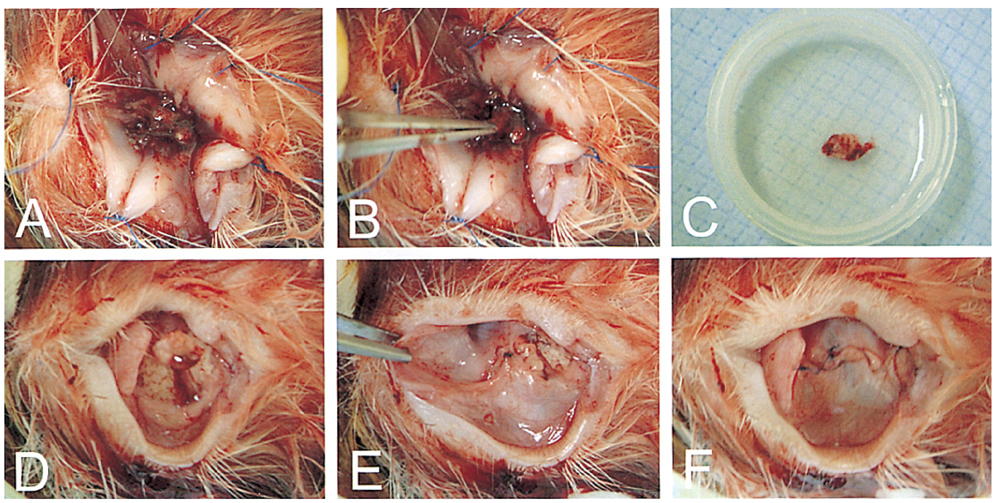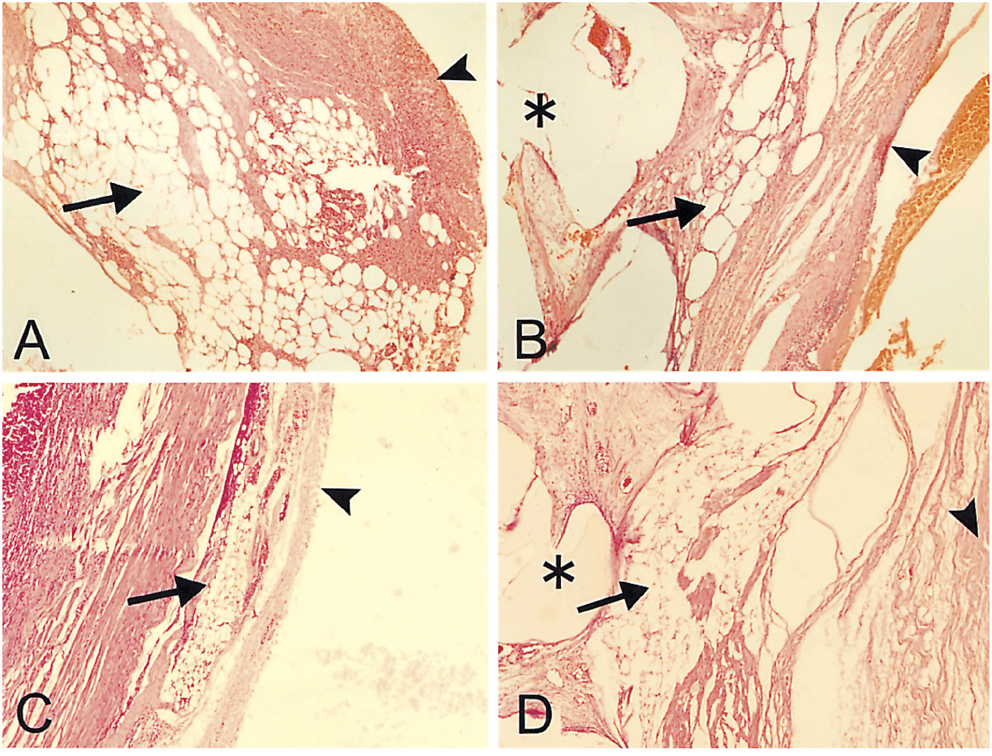Korean J Ophthalmol.
2006 Sep;20(3):143-146. 10.3341/kjo.2006.20.3.143.
The Survival of Freely Grafted Orbital Fat on Porous Polyethylene Orbital Implants in the Rabbit
- Affiliations
-
- 1Department of Ophthalmology, Seoul National University College of Medicine, Seoul, Korea. khwarg@.snu.ac.kr
- 2Department of Ophthalmology, Seoul National University Bundang Hospital, Seoul, Korea.
- 3Department of Ophthalmology, Seoul National University Boramae Hospital, Seoul, Korea.
- 4Artificial Eye Center, Seoul National University Hospital Clinical Research Institute, Seoul, Korea.
- KMID: 754569
- DOI: http://doi.org/10.3341/kjo.2006.20.3.143
Abstract
- PURPOSE: To investigate the long term survival of orbital fat grafted on a Medpor(R) implant as a method of preventing porous polyethylene orbital implant (Medpor(R)) exposure in anophthalmic sockets. METHODS: In one orbit in each of 8 rabbits, a small amount of retrobulbar orbital fat was grafted between the anterior surface of the Medpor(R) implant and overlying conjunctiva, during the enucleation and Medpor(R) implantation procedure. Two rabbits were sacrificed at 2, 4, 8 and 12 weeks postoperatively and grafted orbital fats were examined by light microscopy. RESULTS: Grafted orbital fat was well-maintained at 2 and 4 weeks, postoperatively. However, fat amounts were significantly reduced at 8 weeks, and viable fat was barely visible at 12 weeks. CONCLUSIONS: In rabbits, orbital fat grafted on Medpor(R) implants was gradually resorbed, and the fat-occupied volume was not maintained.
Keyword
MeSH Terms
Figure
Reference
-
1. Dutton JJ. Coralline hydroxyapatite as an ocular implant. Ophthalmology. 1991. 98:370–377.2. Karesh JW, Dresner SC. High-density porous polyethylene (Medpor®) as a successful anophthalmic socket implant. Ophthalmology. 1994. 101:1688–1696.3. Karcioglu ZA, Al-Mesfer SA, Mullaney PB. Porous polyethylene orbital implant in patients with retinoblastoma. Ophthalmology. 1998. 105:1131–1136.4. Lee V, Subak-Sharpe I, Hyngerford JL, et al. Exposure of primary orbital implants in postenucleation retinoblastoma patients. Ophthalmology. 2000. 107:940–945.5. Kim JH, Khwarg SI, Choung HK, et al. Management of porous polyethylene implant exposure in patients with retinoblastoma following enucleation. Ophthalmic Surg Lasers Imaging. 2004. 35:446–452.6. Kim NJ, Choung HK, Khwarg SI. Free orbital fat graft to prevent porous polyethylene orbital implant exposure in patients with retinoblastoma. Ophthal Plast Reconstr Surg. 2005. 21:253–258.7. Ersek RA. Transplantation of purified autologous fat: a 3-year follow-up is disappointing. Plast Reconstr Surg. 1991. 87:219–227.8. Kononas TC, Bucky LP, Hurley C, May JW Jr. The fate of suctioned and surgically removed fat after reimplantation for soft-tissue augmentation: a volumetric and histologic study in the rabbit. Plast Reconstr Surg. 1993. 9:763–768.9. Fagrell D, Enestrom S, Berggren A, Kniola B. Fat cylinder transplantation: an experimental comparative study of three different kinds of fat transplants. Plast Reconstr Surg. 1996. 98:90–96.10. Ghobadi F, Zangeneh M, Massoud BJ. Free fat autotransplantation for the cosmetic treatment of first web space atrophy. Ann Plast Surg. 1995. 35:197–200.11. Cortese A, Savastano G, Felicetta L. Free fat transplantation for facial tissue augmentation. J Oral Maxillofac Surg. 2000. 58:164–169.
- Full Text Links
- Actions
-
Cited
- CITED
-
- Close
- Share
- Similar articles
-
- Scleral Eversion Technique for Porous Polyethylene Orbital Implant after Evisceration
- Management of Exposed Porous Orbital Implants
- Porous Polyethylene/Titanium Implants in the Treatment of Large Orbital Fractures
- Clinical Effect of Porous Polyethylene (Medpor(r))Orbital Implant
- Porous Polyethylene in the Repair of Late Posttraumatic Enophthalmos



